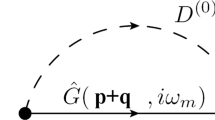Abstract
Eliashberg–McMillan theory of superconductivity is essentially based on the adiabatic approximation. Small parameter of perturbation theory is given by λ\(\frac{{{{\Omega }_{0}}}}{{{{E}_{{\text{F}}}}}}\) ≪ 1, where λ is the dimensionless electron–phonon coupling constant, Ω0 is characteristic phonon frequency, while EF is Fermi energy of electrons. Here we present an attempt to describe the electron–phonon interaction within Eliashberg–McMillan approach in situation, when characteristic phonon frequency Ω0 becomes large enough (comparable to, or exceeding, the Fermi energy EF). We consider the general definition of electron–phonon pairing coupling constant λ, taking into account the finite value of phonon frequency. Also, we obtain the simple expression for generalized coupling constant \(\tilde {\lambda }\) that determines the mass renormalization, with the account of finite width of conduction band, which describes the smooth transition from the adiabatic regime to the region of strong nonadiabaticity. In the case of strong nonadiabaticity, when Ω0 ≫ EF, the new small parameter appears, λ\(\frac{{{{E}_{{\text{F}}}}}}{{{{\Omega }_{0}}}}\) ~ λ\(\frac{D}{{{{\Omega }_{0}}}}\) ≪ 1 (D is conduction band half-width), and corrections to electronic spectrum become irrelevant. At the same time, the temperature of superconducting transition Tc in antiadiabatic limit is still determined by Eliashberg–McMillan coupling constant λ, while the preexponential factor in the expression for Tc, conserving the form typical of weak-coupling theory, is determined by the bandwidth (Fermi energy). For the case of interaction with a single optical phonon, we derive the single expression for Tc, valid both in adiabatic and antiadiabatic regimes and describing the continuous transition between these two limiting cases. The results obtained are discussed in the context of superconductivity in FeSe/STO.


Similar content being viewed by others
REFERENCES
D. J. Scalapino, in Superconductivity, Ed. by R. D. Parks (Marcel Dekker, New York, 1969), p. 449.
S. V. Vonsovsky, Yu. A. Izyumov, and E. Z. Kurmaev, Superconductivity of Transition Metals, Their Alloys and Compounds (Nauka, Moscow, 1977; Springer, Berlin, Heidelberg, 1982).
P. B. Allen and B. Mitrović, Solid State Physics, Ed. by F. Seitz, D. Turnbull, and H. Ehrenreich (Academic, New York, 1982), Vol. 37, p. 1
L. P. Gor’kov and V. Z. Kresin, Rev. Mod. Phys. 90, 011001 (2018)
A. B. Migdal, Sov. Phys. JETP 7, 996 (1958).
A. S. Alexandrov and A. B. Krebs, Phys. Usp. 35, 345 (1992).
I. Esterlis, B. Nosarzewski, E. W. Huang, D. Moritz, T. P. Devereux, D. J. Scalapino, and S. A. Kivelson, Phys. Rev. B 97, 140501(R) (2018)
M. V. Sadovskii, Phys. Usp. 51, 1243 (2008).
L. P. Gor’kov, Phys. Rev. B 93, 054517 (2016)
L. P. Gor’kov, Phys. Rev. B 93, 060507 (2016)
J. R. Schrieffer, Theory of Superconductivity (Fizmatlit, Moscow, 1968; W. A. Benjamin, New York, 1964).
M. V. Sadovskii, Diagrammatics (ICS, Moscow, Izhevsk, 2010; World Scientific, Singapore, 2006).
P. B. Allen, Phys. Rev. B 6, 2577 (1972)
M. Kulić, AIP Conf. Proc. 715, 75 (2004) arXiv:1712.06222
J. J. Lee, F. T. Schmitt, R. G. Moore, S. Johnston, Y. T. Cui, W. Li, Z. K. Liu, M. Hashimoto, Y. Zhang, D. H. Lu, T. P. Devereaux, D. H. Lee, and Z. X. Shen, Nature (London, U.K.) 515, 245 (2014)
O. V. Danylenko, O. V. Dolgov, M. L. Kulic[acute], and V. Oudovenko, Eur. J. Phys. B 9, 201 (1999)
M. L. Kulic[acute], AIP Conf. Proc. 715, 75 (2004)
L. Rademaker, Y. Wang, T. Berlijn, and S. Johnston, New J. Phys. 18, 022001 (2016)
Y. Wang, K. Nakatsukasa, L. Rademaker, T. Berlijn, and S. Johnston, Supercond. Sci. Technol. 29, 054009 (2016)
I. A. Nekrasov, N. S. Pavlov, and V. V. Sadovskii, JETP Lett. 105, 370 (2017).
I. A. Nekrasov, N. S. Pavlov, and M. V. Sadovskii, J. Exp. Theor. Phys. 126, 485 (2018).
Fengmiao Li and G. A. Sawatzky, Phys. Rev. Lett. 120, 237001 (2018)
Y. Wang, A. Linscheid, T. Berlijn, and S. Johnson, Phys. Rev. B 93, 134513 (2016)
M. A. Ikeda, A. Ogasawara, and M. Sugihara, Phys. Lett. A 170, 319 (1992)
Author information
Authors and Affiliations
Corresponding author
Additional information
The article is published in the original.
Rights and permissions
About this article
Cite this article
Sadovskii, M.V. Electron–Phonon Coupling in Eliashberg–McMillan Theory Beyond Adiabatic Approximation. J. Exp. Theor. Phys. 128, 455–463 (2019). https://doi.org/10.1134/S1063776119020122
Received:
Revised:
Accepted:
Published:
Issue Date:
DOI: https://doi.org/10.1134/S1063776119020122




